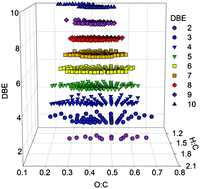Molecular composition of limonene/O3 secondary organic aerosol (SOA) was investigated using high-resolution electrospray ionization mass spectrometry (HR-ESI-MS) as a function of reaction time. SOA was generated by ozonation of D-limonene in a reaction chamber and sampled at different time intervals using a cascade impactor. The SOA samples were extracted into acetonitrile and analyzed using a HR-ESI-MS instrument with a resolving power of 100 000 (m/Δm). The resulting mass spectra provided detailed information about the extent of oxidation inferred from the O : C ratios, double bond equivalency (DBE) factors, and aromaticity index (AI) values in hundreds of identified individual SOA species. The chemical composition of SOA was approximately the same for all size-fractionated samples studied in this experiment (0.05 to 0.5 μm range). The SOA constituents quickly reached an average O : C ratio of 0.43, which grew to 0.46 after one hour of additional oxidation of particles by the excess ozone. The dominant mechanism of oligomerization, inferred from high resolution ESI-MS data, was reaction between Criegee intermediates and stable first-generation products of limonene ozonolysis. Although the SOA composition was dominated by various oxidized aliphatic compounds, a small fraction of products appeared to contain aromatic rings. SOA generation was also studied in the presence of UV radiation and at elevated relative humidity (RH). The presence of UV radiation had a negligible effect on the SOA composition. The presence of water vapor resulted in a slight redistribution of peak intensities in the mass spectrum likely arising from hydration of certain SOA constituents. The data are consistent with fast production of the first-generation SOA constituents, including oligomers, followed by very slow aging processes that have a relatively small effect on the average molecular composition on the timescale of our experiments.

You have access to this article
 Please wait while we load your content...
Something went wrong. Try again?
Please wait while we load your content...
Something went wrong. Try again?


 Please wait while we load your content...
Please wait while we load your content...